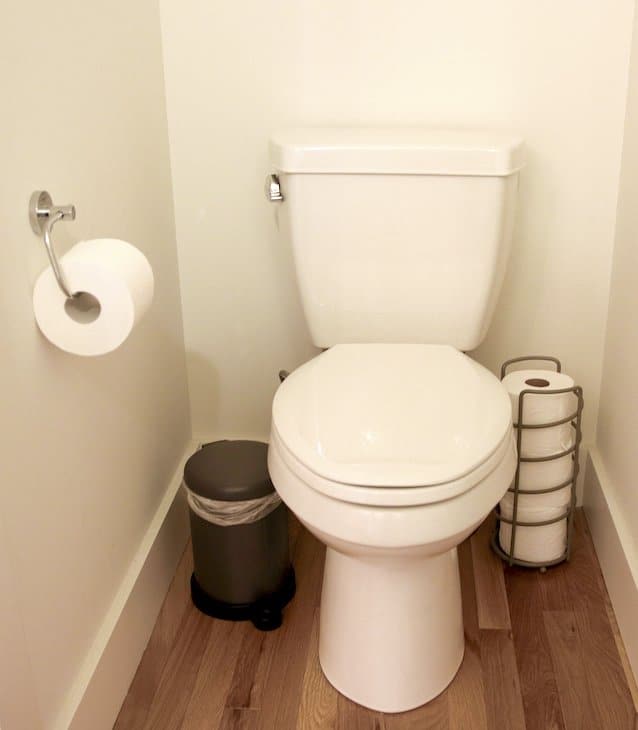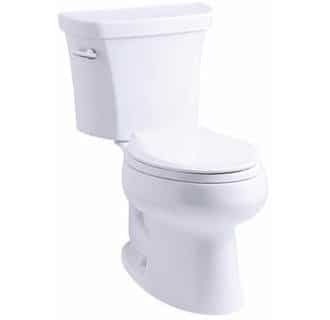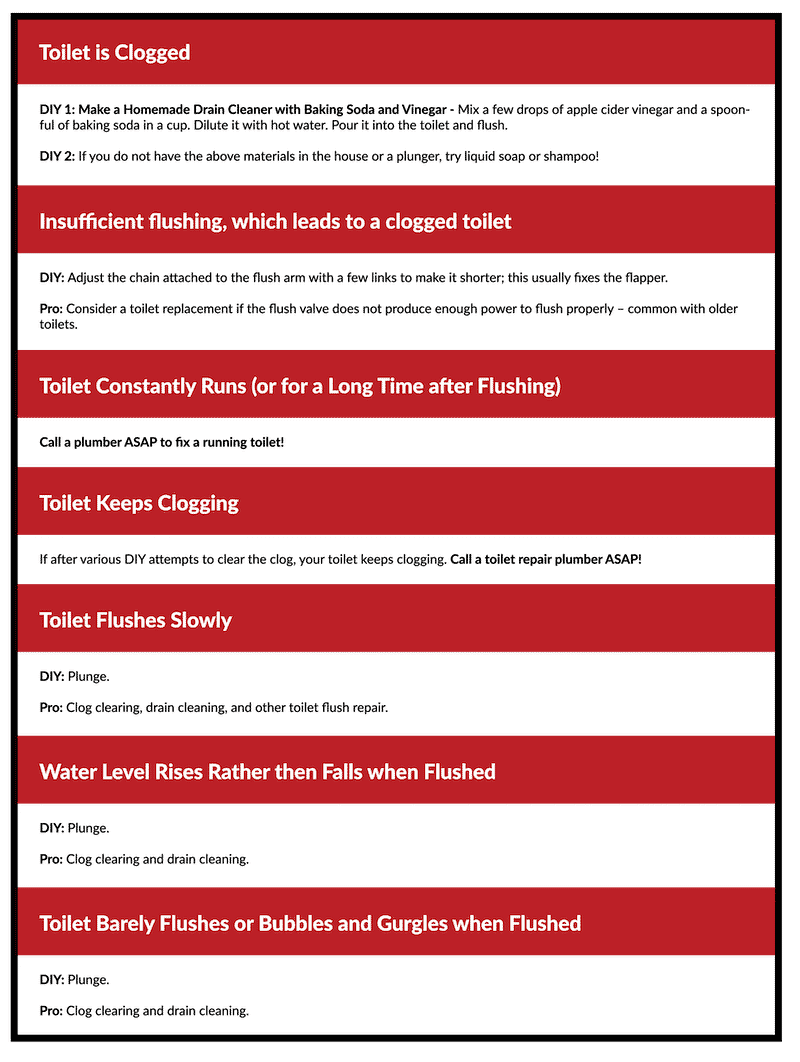
- Identify the cause of the toilet clog
- Verify the type of toilet you are using
- Try using a plunger
- Adjust the toilet flapper chain
- Use a toilet snake or auger
- Free the clog with hot water
- Know when to call a plumber
Learning these steps can help you avoid big problems before they happen, and will help you identify when it’s time to try DIY fixes or call a plumber.
Common Causes of Toilet Clogs
Even though the toilet is the most used seat in the house, we seldom give it a second thought when it’s flushing fine. But what should you do when it doesn’t flush? Knowing how to unclog a toilet can save you from major embarrassment and an even bigger mess.
Foreign Objects Can Cause Chaos
We all know what the toilet is used for, and quite frankly, it shouldn’t be used for much else. Despite this, many are guilty of using the toilet as a convenient wastecan for other items beyond toilet paper and human waste. Foreign objects flushed down the toilet can easily clog up your pipes and cause you a major headache.
Keep These Items Out of Your Toilet:
- Feminine products, tissues, paper towels, and cotton: While in your pipes, these items will do their job to collect liquids and expand, eventually causing a clog.
- Hair and floss: These can easily wrap around other waste in your pipes and grow in size until it clogs your toilet.
- Food and grease: Cooking oil and grease seem to be harmless until they are flushed and left to harden within piping. According to the Water Corporation, the solidification of fats, oils, and grease account for 30% of clogs in our wastewater system. Food scraps are also clogging culprits that belong in the trash.
- Chewing gum: Gum does not dissolve in water. Dodge a sticky situation in your pipes by spitting out your gum in the trash rather than your toilet.
- Pet Waste: Flushing any animal waste down the toilet can lead to water contamination, or even worse, clogs. Kitty litter, which collects waste by clumping when wet, should avoid the toilet too.
- ‘Flushable’ wipes: Wet wipes don’t disintegrate easily like toilet paper does. Always avoid flushing these, even if the packaging says otherwise!
- Other bathroom basics: Bandages are bound to be in your medicine cabinet. These are non-biodegradable, so they are best disposed of in a waste bin. Unused or old medications may also lay dormant in your medicine cabinet. Resist the urge to pop these in the toilet, as they can contaminate water. Dispose of them safely at a pharmacy or other medicine disposal program.
Teach Curious Kids Good Toilet Etiquette
It’s all fun and games until the toilet becomes your child’s next favorite toy. Fortunately, there are steps you can take to minimize the consequences of curious kids on your plumbing. Stop kids from flushing the unflushable by talking these steps.
Talk To Children About Toilet Etiquette
Take time to explain to little ones that their belongings will never come back if they flush them. The risk of losing a beloved toy might keep them from looking for trouble (in the toilet, at least).
Practice What You Preach
Back up your pleas to not play in the potty by modeling the correct way of treating your home’s plumbing. Put a list of non-flushable items or a trash can by your home’s toilet as reminders about what is and what is not appropriate to flush.
Childproof Your Bathroom
To protect your toilet from extra curious kids, you can lock it down with a flush-lever or toilet seat lock. You can also place a lock on the bathroom door to keep your youngster from entering the washroom without you. And remember, an added danger of drowning must be taken seriously wherever water exists.
How Do You Unclog a Toilet? Try These Steps
Review some of the more common issues to unclogging a toilet when it’s blocked or not flushing efficiently.

When Low Flow Toilets Clog
Low flow toilets — especially the older models — have a tendency to clog. Check the back of your toilet for a stamped date: if it was made in the mid-1990s, the toilet may be a first-generation low flow model. These often lack the proper pressure to move waste through drains, which could lead to clogs.
DIY Fix: Instead of rushing into a replacement, you can try limiting clogs while using these toilets by cutting down on toilet paper and keeping other clog-causing items out. If this doesn’t do the trick, it may be time to consider upgrading to a newer model.
How To Plunge A Toilet
The steps for how to unclog a toilet with a plunger include:
- Turn off the water supply hose located behind the toilet. Make sure the toilet flapper valve in the tank is down.
- Either remove or add water to the toilet bowl so the water level is halfway up to the brim
- Make sure the plunger’s flange is outside of the cup. Insert the flange into the toilet bowl drain opening.
- Push and pull the plunger in a vertical motion while avoiding breaking the seal. Continue this thrusting motion until you unclog the toilet.
Plunging your toilet becomes a go-to when the toilet trap is jammed. The toilet trap is the u-shaped bend in the pipe that extends from the bottom of the toilet bowl to the drainpipe. It remains filled with water to block foul odors from the sewer line from entering your home. Unfortunately, its curved shape makes it extra susceptible to clogs.
DIY Fix: If you suspect that your toilet trap is jammed, try clearing the clog using a trusty plunger. A toilet plunger is the ideal choice because it has a special extension called a flange that is designed for toilet drains. Although mastering how to unclog a toilet with a plunger takes practice, it can be done with a little effort.
How to Fix a Faulty Toilet Flapper
An ineffective toilet flapper can also be at fault. The toilet flapper is the rubber seal at the bottom of the toilet tank that allows for water to flow out of the tank and into the bowl when flushed. A faulty flapper may not provide enough power for the flush to move the waste through the pipe, resulting in a clog.
DIY Fix: The flapper is attached to the flush arm, which has a chain. Adjusting the chain a few links to make it shorter usually fixes the flapper.
How to Fix a Clogged Toilet – Other DIY Repairs
Other popular techniques to try when unclogging a toilet include:
- Brush it away: Grab a toilet brush and sweep it up and down the drain with the bristles angled down to clear things up.
- Snake it out: A toilet auger, or plumbing snake, rotates as it’s pushed through the toilet drain into the pipe. This rotating motion helps it to break up stubborn clogs. If you’re feeling extra crafty, you can also fashion a homemade plumber’s snake from a coat hanger.
- Melt the clog: Put pressure on the clog by pouring hot (not boiling) water into the toilet bowl. Add soap into the mix to act as a lubricant. This combination will help to get clogs moving smoothly along.
- Force it out: Fill a plastic bottle with warm water, then put the top of the bottle into the toilet’s drain opening. Squeeze the bottle to create pressure to dislodge whatever debris is causing the clog.
When to Call a Plumber to Fix Your Toilet
There may be instances when it’s time to call in a professional plumber to unclog and fix your toilet. Get started with our Nashville Toilet Repair services. Some of the more common problems that merit a plumbing contractor include:
You Have Issues Down The Line
Larger sewer line problems may have you scratching your head as to how to unclog the toilet when nothing works–even the trusty plunger. This is because the issue is deeper in the sewer, either from an accumulation of waste, or even tree roots. A plumber may perform a camera inspection of your sewer line to figure out what’s going on.
Hard Water Is Getting In The Way Of Flushing
Hard water, caused by an abundance of minerals, can calcify inside drain pipes and reduce water flow. This can cause toilet clogs over time. To combat this, a professional can flush out your system or install a water softener that prevents mineral buildup as a more long-term fix.
You Are Facing Other Toilet Troubles
Modern toilets tote a vent on the roof that prevent odors from entering the house, while allowing wastewater gases to exit. This vent can get congested with leaves and other debris, which reduces drain flow and causes clogs.
Usually, a clogged toilet only gets worse the longer you delay. Take action immediately to clear the clog. Contact us if your toilet troubles cannot be easily solved, or if safety becomes a concern. Better be safe than soggy.
Signs Your Toilet May Need Repairs

FAQs About Unclogging Toilets
For those times when you don’t have a plunger on hand or it fails to clear the clog, you can try to use a toilet brush or plumber’s snake to break up the blockage. You can also pour soapy and hot (but not boiling) water into the toilet bowl to try to melt the clog and get it moving.
Be careful when using household chemicals as mixing them can lead to explosions or noxious fumes. Make sure to wear personal protective gear like gloves and glasses if you go this route. Avoid using Drano or Liquid-Plumr as these are dangerous for you and your pipes. A completely natural–and less risky–way to unclog your toilet is to pour a mixture of hot and soapy water into your toilet bowl and let it sit for 30 minutes to an hour.
Although frustrating, clogged toilets are a common household problem. Mixing chemical solutions to try to clear toilet clogs should be avoided. Instead, try to use a plunger or plumber’s snake to unclog it. If that is not doing the trick, you can count on our licensed plumbers to help fix even your worst toilet troubles!
Find more solutions from Hoffmann Brothers on our How to Unclog a Drain page.


